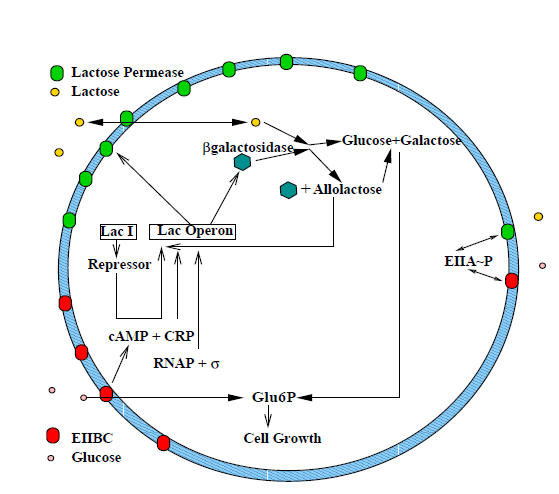Team:Imperial College London/Drylab/Autoinduction/Model3
From 2009.igem.org
(Difference between revisions)
(→Model Rationale) |
|||
| Line 7: | Line 7: | ||
** Catabolite repression: Repression of cAMP by high levels of glucose present in the medium at the start of the culture, also preventing transcription of the lac operon. | ** Catabolite repression: Repression of cAMP by high levels of glucose present in the medium at the start of the culture, also preventing transcription of the lac operon. | ||
*When glucose runs out, the lac operon is induced. | *When glucose runs out, the lac operon is induced. | ||
| - | *When lactose is transported into the cell (by lac permease) and | + | *When lactose is transported into the cell (by lac permease) and hydrolised into smaller chain length carbon sources by b-galactosidase. |
*Glucose-6-phosphate amounts control the rate of growth of the cell culture. | *Glucose-6-phosphate amounts control the rate of growth of the cell culture. | ||
[[Image:II09_Zhao_Lu_diaux.png|400px]]<br> | [[Image:II09_Zhao_Lu_diaux.png|400px]]<br> | ||
| Line 21: | Line 21: | ||
==Model predictions== | ==Model predictions== | ||
| - | + | *In this model two hypotheses for catabolite repression are tested: | |
| + | **Catabolite repression is dependent on extracellular glucose concentrations. | ||
| + | **Catabolite repression is dependent on the rate of transport of glucose into the cell. | ||
| + | *The question posed from the two possible catabolite repression pathways is: Will one or the other have a significant effect on the outcome of the model? | ||
| + | *Furthermore, two hypotheses for the phosphorilation of glucose produced from lactose hydrolysis were tested: | ||
| + | **Phosphorilation by intracellular hexokinase | ||
| + | **Secretion of glucose and phosphorilation once it is transported back into the cell. | ||
| + | The second hypotheses would be predicted to add to the effect of catabolite repression. | ||
===The actual model...=== | ===The actual model...=== | ||
{{Imperial/09/TemplateBottom}} | {{Imperial/09/TemplateBottom}} | ||
Revision as of 15:54, 18 October 2009

Contents |
Model Rationale
Several models have focused on inducing the lac operon using IPTG[1 (ref fro protein prod)] but not many have focused on induction by lactose.
The Keasling model in the system describes diauxic growth under the presence of glucose and lactose, and includes the different stages of metabolism of both sources. Here are the main points to remember:
- The lac operon is controlled by glucose at 2 levels: Inducer exclusion and catabolite repression.
- Inducer exclusion: Relates to the constitutive expression of LacI repressor protein (see protein production pages for more on this), originally repressing the Lac operon.
- Catabolite repression: Repression of cAMP by high levels of glucose present in the medium at the start of the culture, also preventing transcription of the lac operon.
- When glucose runs out, the lac operon is induced.
- When lactose is transported into the cell (by lac permease) and hydrolised into smaller chain length carbon sources by b-galactosidase.
- Glucose-6-phosphate amounts control the rate of growth of the cell culture.
Model Assumptions
Model predictions
- In this model two hypotheses for catabolite repression are tested:
- Catabolite repression is dependent on extracellular glucose concentrations.
- Catabolite repression is dependent on the rate of transport of glucose into the cell.
- The question posed from the two possible catabolite repression pathways is: Will one or the other have a significant effect on the outcome of the model?
- Furthermore, two hypotheses for the phosphorilation of glucose produced from lactose hydrolysis were tested:
- Phosphorilation by intracellular hexokinase
- Secretion of glucose and phosphorilation once it is transported back into the cell.
The second hypotheses would be predicted to add to the effect of catabolite repression.
The actual model...
 "
"




